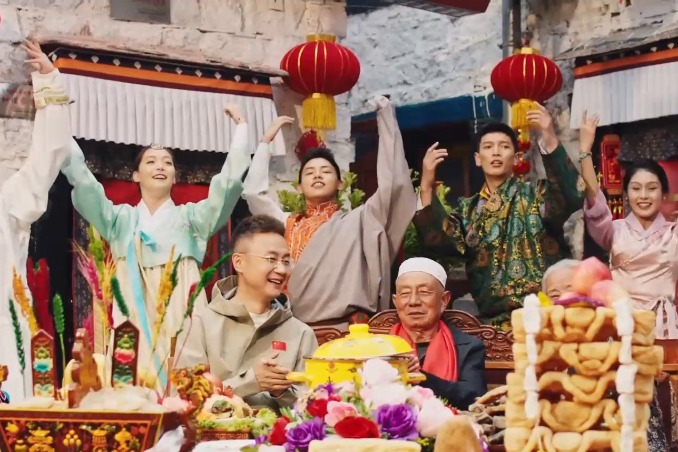WALKING IN A YOUNG MASTER'S FOOTSTEPS
Visitors get an opportunity to experience the hometown life of a pivotal literary figure, Wang Ru reports in Shaoxing, Zhejiang province.

Dark tiles, white walls, wooden lattice windows and black-awning boats — people who visit the Shaoxing Lu Xun Native Place in Shaoxing, Zhejiang province, can still view what Lu Xun saw more than a century ago and trace his footsteps from a young master of a declining family into a pivotal figure of contemporary Chinese literature.
Nestled within the ancient city of Shaoxing, with a history of over 2,500 years, this scenic spot holds the cherished childhood memories of Lu Xun. It is a place brimming with captivating stories, attracting countless visitors to immerse themselves in its rich cultural significance.
Zhou Shuren (1881-1936), better known by his pen name Lu Xun, left an indelible mark on the literary landscape and cultural ethos of China with his extensive body of work spanning novels, essays and poems, often exposing the dark side of society and human nature in sarcastic and insightful writings.
This scenic destination offers a tapestry of locations associated with Lu Xun, including his familial home where he was born and raised; his ancestral abode; the Sanwei Private School where he studied as a teenager; Baicao Garden, his cherished childhood retreat; and the Lu Xun Memorial Museum.
"Apart from many other writers, Lu Xun wrote a lot about his hometown," says Yu Jia, deputy director of the museum. "He not only depicted many of his childhood memories but also shaped characters based on people he met when he was young. As a result, you can see how his works closely relate to his early experiences."
Lu Xun was born into a prominent family in 1881. His ancestors are recorded to have moved to Shaoxing during the middle period of the Ming Dynasty (1368-1644). Initially engaged in farming, they later ventured into business, amassing enough wealth to acquire two sizable complexes during the Qing Dynasty (1644-1911), says Hu Jingwen, director of the management department of Shaoxing Lu Xun Native Place.
Family members were encouraged to receive education and seek higher social status since, in ancient China, passing the imperial exam was almost the only way the underprivileged could become officials to elevate family standing. Lu Xun's grandfather Zhou Fuqing (1838-1904) achieved this feat. However, in 1893, his illegal involvement in bribery was exposed, leading to his subsequent imprisonment. Alongside his downfall, the family fortune declined as well, she adds.
Young Lu Xun experienced the whole process, transitioning from a respected young master to someone who had to mortgage family properties in exchange for medicine for his father. He once wrote: "Have you ever witnessed your own prosperous family fall into destitution? I believe in this process, you can really see people's true colors."
"We know Lu Xun was a great thinker and the event greatly influenced him. It allowed him to broaden his perspective and gain a deeper understanding of the world, which greatly influenced the depth and profundity of his thoughts," says Hu.
At Sanwei Private School, the complex where Lu Xun began receiving his education at age 11 with teacher Shou Jingwu, people can see a desk carved with the character zao (early) on the corner of the desk. It is a replica of the desk used by Lu Xun, with the real one exhibited in the museum.
According to Hu, there was an incident when Lu Xun was late for school and received criticism from Shou. Even though he was delayed due to purchasing medicine for his father's illness, Lu Xun did not attempt to make excuses. Instead, he engraved the character on his desk as a reminder to never be late again.
"This shows Lu Xun's spirit of being strict with himself and his awareness of self-examination," says Hu.
Visitors can also see a bookmark at the museum that was made by Lu Xun when he was studying at the school. He wrote, "Reading books requires three arrivals — arrivals of heart, eyes and mouth" — on the bookmark.
"This shows he was diligent and worked very hard. He tried to find his way of learning and improving," says Hu.
Lu Xun spent 18 years at the complex and experienced many unforgettable moments. Some of them are recorded in From Baicao Garden to Sanwei Private School, a renowned article in which he reminisced about his childhood filled with nostalgia. Written in his 40s, this piece holds particular significance as it was selected to be included in middle school textbooks across China.
"Let's refrain from mentioning the verdant vegetable plot, the sleek stone well enclosure, the towering honey-locust tree, and the purplish-red mulberry fruits. ... Instead, let's focus on the sheer delight that the vicinity of the mud wall base offered," he wrote in the article.
According to Yu, visitors can still see "the verdant vegetable plot", "the towering honey-locust tree" and even "the mud wall base" at the present-day Baicao Garden and cherish Lu Xun's childhood fun.
Besides following in the writer's footsteps, the tourist attraction is a good example of the cultural characteristics of Shaoxing ancient city, which has kept its location unchanged since King Gou Jian of the Yue state from the Spring and Autumn Period (770-476 BC) built it in 490 BC, says Chen Yang, an expert on the protection of the ancient city.
"The biggest characteristic of the Shaoxing ancient city is that the site has remained unchanged for over 2,500 years. Even after millennia, numerous people live in the ancient city, forging a shared growth between the inhabitants and the historic surroundings. It is a living ancient city, one that possesses vitality and life," says Chen.
Hu says the complex offers a glance into Shaoxing's water town landscape. "The traditional residences in Shaoxing, with their white walls, black tiles and wooden lattice windows, exude an elegant architectural charm," says Hu.
"For example, the exit of Sanwei Private School presents crisscrossing waterways, with buildings lining the riverside, forming a unique architectural style. In the waterways, you can see black-awning boats shuttling through, which truly embodies the charm of Shaoxing as a water town," she adds.
In recognition of Lu Xun's portrayal of various folk activities in Shaoxing, the native place has organized events to promote its traditions. For instance, an exhibition last year at the museum showcased shexi, a type of folk opera, emphasizing its charm as depicted in his writings.
According to Chen, the native place attracts about 4 million visitors a year, making it one of the most popular scenic spots in Shaoxing.
Chen highlights the site's successful integration of culture and tourism. "Many individuals, young and old, have grown up reading Lu Xun's writings. We encourage visitors to embark on a tour of Shaoxing following these literary works. They are eager to witness firsthand the places they have read about and to explore the city through the lens of Lu Xun," says Chen.



Today's Top News
- Gaza 'takeover' will ignite another horrific chapter for the Middle East: China Daily editorial
- STAR shines for innovative companies
- For a more inclusive global future
- Diplomatic solution for Ukraine crisis sought
- Consumption gains steam, drives growth
- Summit seen as chance to warm Sino-Indian ties






























